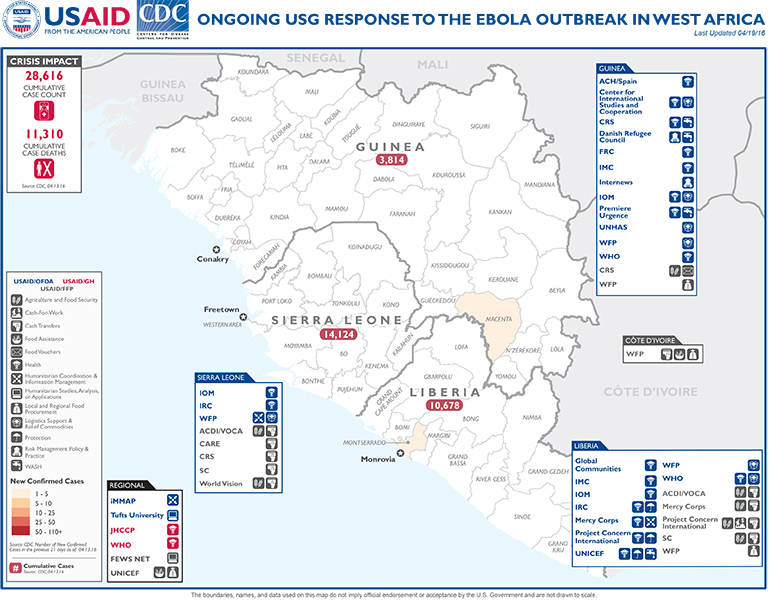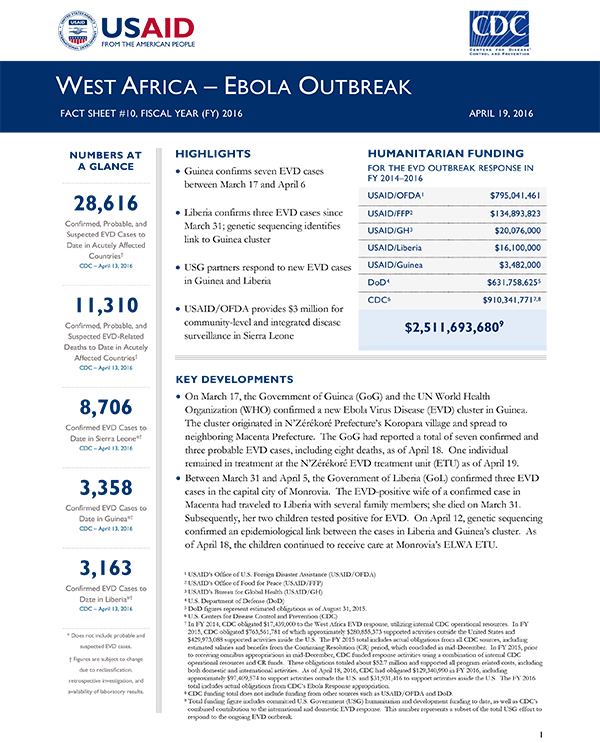April 19, 2016
HIGHLIGHTS
Ebola Response
Visit our main West Africa Ebola Outbreak page to learn more about how we're responding to the West Africa Ebola outbreak, and what you can do to help.
- Guinea confirms seven EVD cases between March 17 and April 6.
- Liberia confirms three EVD cases since March 31; genetic sequencing identifies link to Guinea cluster.
- USG partners respond to new EVD cases in Guinea and Liberia.
- USAID/OFDA provides $3 million for community-level and integrated disease surveillance in Sierra Leone.
KEY DEVELOPMENTS
West Africa Map - 04-19-2016 ![]() (pdf - 586k)
(pdf - 586k)
- On March 17, the Government of Guinea (GoG) and the UN World Health Organization (WHO) confirmed a new Ebola Virus Disease (EVD) cluster in Guinea. The cluster originated in N'Zérékoré Prefecture's Koropara village and spread to neighboring Macenta Prefecture. The GoG had reported a total of seven confirmed and three probable EVD cases, including eight deaths, as of April 18. One individual remained in treatment at the N'Zérékoré EVD treatment unit (ETU) as of April 19.
- Between March 31 and April 5, the Government of Liberia (GoL) confirmed three EVD cases in the capital city of Monrovia. The EVD-positive wife of a confirmed case in Macenta had traveled to Liberia with several family members; she died on March 31. Subsequently, her two children tested positive for EVD. On April 12, genetic sequencing confirmed an epidemiological link between the cases in Liberia and Guinea’s cluster. As of April 18, the children continued to receive care at Monrovia’s ELWA ETU.
Guinea
The GoG and WHO confirmed seven EVD cases between March 17 and April 6. Health workers have linked the new cases—four in N’Zérékoré and three in Macenta—to three community deaths in Koropara between February 27 and March 15, later identified as probable cases. Guinea’s most recent case, a traditional healer identified as EVD-positive on April 6, remained in treatment at the N’Zérékoré ETU as of April 19.
As of April 18, response actors were following more than 150 contacts, including nearly 80 high-risk contacts, with a contact follow-up rate of 100 percent. The GoG and WHO commenced vaccination efforts targeting contacts of confirmed cases in N’Zérékoré on March 24 and in Macenta on March 26. By April 8, nearly 1,510 contacts—including more than 240 classified as high-risk—had received the EVD vaccine in N’Zérékoré and Macenta.
The GoG National Ebola Coordination Cell is leading the response to the current EVD cluster. On March 24, the GoG instituted micro-cerclage—a strategy of limiting movement from affected villages, tracing known and suspected contacts, and monitoring suspicious illnesses and deaths—around Koropara. The UN World Food Program (WFP) completed food distributions—consisting of two bags of rice and five liters of oil per household—to more than 180 households participating in micro-cerclage on March 26. WFP also provided cash to families affected by micro-cerclage to discourage travel outside Koropara during the 21-day monitoring period. On April 16, staff from the National Ebola Coordination Cell and other response actors marked the end of micro-cerclage for Koropara sub-prefecture, as contacts in this area had completed a 21-day monitoring period.
On March 22, USAID/OFDA partner the International Organization for Migration (IOM) installed three sanitary checkpoints near Koroh and Kpeida villages, which border Koropara village, to screen residents for fever at frequently used transit points. IOM also deployed 30 agents to nearby Guéckédou, Lola, N’Zérékoré, and Yomou prefectures to conduct community mapping exercises in vulnerable areas—including borders, markets, and schools—to determine where to place additional checkpoints. IOM is closely coordinating with the National Ebola Coordination Cell to identify other border areas for intensified surveillance and sanitary checkpoints. The National Ebola Coordination Cell reports that Guinea currently has at least 40 open border crossings into Liberia. Maintaining open, legal border crossings is critical for disease surveillance—when individuals cross informally, such as through forests, the ability for EVD actors to identify contacts lessens considerably.
As of mid-April, teams from USAID/OFDA partners Catholic Relief Services (CRS) and WHO continued to conduct ring infection prevention and control (IPC) activities—including assessing adherence to IPC protocols, training health care workers on protocols, and providing IPC supplies—at four health facilities in affected areas of N’Zérékoré.
USAID/OFDA partner the French Red Cross (FRC) maintains an ETU on standby in Macenta that response actors can reactivate within 48 hours, if needed. In addition, an FRC physician deployed to N’Zérékoré on March 31 to assist with case management and vaccine administration.
Liberia
On March 31, health care workers confirmed a new EVD case in Monrovia following a post-mortem test. The EVDpositive woman, a high-risk contact of an EVD case in Macenta, had recently traveled to Liberia with family members. Health care workers had admitted all family members to Monrovia’s ELWA ETU for close surveillance by April 5. Of the family members, two children tested positive for EVD. Health care workers reported that the children were no longer exhibiting EVD symptoms and plan to discharge the children following two consecutive EVD-negative tests; the children remained in palliative care as of April 19. As of April 15, response actors were following approximately 70 contacts in Liberia, including 25 high-risk contacts of the recent cases, with a 100 percent contact follow-up rate. As of April 13, more than 110 contacts in Liberia had received the EVD vaccine.
Non-governmental organization partners from a USAID/OFDA-supported epidemic preparedness and response (EPR) consortium bolstered preparedness and response activities in Bong, Lofa, Margibi, Montserrado, and Nimba counties—which either border Guinea or host transitory populations—following confirmation of the new EVD cluster. EPR Consortium assistance includes case investigation and surveillance, case management, contact tracing, conducting rapid diagnostic tests (RDTs), and logistical support, among other activities, in the five counties.
By April 7, EPR Consortium lead the International Rescue Committee (IRC) had activated eight ambulance teams in Liberia with the capacity to support a 24-hour response. IRC has also deployed staff to assist contact tracing efforts, as well as RDT teams to support case management and burial activities. USAID/OFDA has provided nearly $10.4 million in FY 2016 to support IRC’s response and recovery efforts in Liberia, including the EPR Consortium.
USAID/OFDA staff in Monrovia observed a contact tracing refresher training and met with an IRC-supported mobile RDT team on April 9. The contact tracing training reviewed guidance on interactions with contacts, notification processes for symptomatic contacts, and usage of the contact tracing and case investigation forms. The mobile RDT team—which includes a burial specialist and a nurse—remains on standby at the Monrovia county health team office, awaiting notification of potential cases. With USAID/OFDA support, IRC recently increased its contact tracing teams from 13 to 17.
EPR Consortium member Global Communities continues to lead disinfection efforts and safe burials in all counties. From April 1–3, Global Communities staff disinfected two clinics which treated the recent EVD cases. Additionally, in response to the recent cluster, Global Communities increased its safe burial capacity from five burial teams to eight. Global Communities has managed more than 7,000 safe and dignified burials countrywide since late 2014, and Global Communities-trained burial team members continue to serve on Liberia’s county health teams.
Prior to the current EVD cluster, the EPR Consortium had developed a contingency plan for potential new cases. In March, the consortium developed response contingency plans during simulation exercises in 14 counties in Liberia. During the simulations, county, district, and local health team members drafted response plans for one to two EVD outbreak scenarios, tailored to each county’s post-EVD context.
Sierra Leone
Despite no reported EVD cases since January, the Government of Sierra Leone (GoSL) continues to coordinate case management activities and national-level integrated disease surveillance and response programs while also strengthening district-level health coordination. Following the confirmation of new EVD cases in N’Zérékoré on March 17, the GoSL Public Health National Emergency Operations Center convened on March 19 to discuss preparedness activities, including heightened surveillance efforts in Kailahun Region, which is located along Sierra Leone’s eastern border with Guinea. The GoSL is working with USAID/OFDA partner IOM to strengthen border screening and surveillance in response to the new cases in Guinea and Liberia.
In April, USAID/OFDA provided IRC with more than $3 million to enhance disease surveillance and local-level health capacity through community-event based surveillance (CEBS). With USAID/OFDA support, IRC plans to maintain CEBS activities in Sierra Leone and bolster the integration of disease surveillance and response capacity in Bo, Bombali, Kailahun, Kambia, Kenema, Kono, Moyamba, Pujehun, and Tonkolili districts. Integrating disease surveillance and response capacity into local- and district-level health systems enables health care workers to quickly identify and respond to EVD and other public health threats, preventing future outbreaks.
PUBLIC DONATION INFORMATION
- The most effective way people can assist relief efforts is by making cash contributions to humanitarian organizations that are conducting relief operations. A list of humanitarian organizations that are accepting cash donations for disaster responses around the world can be found at www.interaction.org.
- USAID encourages cash donations because they allow aid professionals to procure the exact items needed (often in the affected region); reduce the burden on scarce resources (such as transportation routes, staff time, and warehouse space); can be transferred very quickly and without transportation costs; support the economy of the disaster-stricken region; and ensure culturally, dietary, and environmentally appropriate assistance.
More information can be found at:
- The Center for International Disaster Information: www.cidi.org or +1.202.821.1999.
- Information on relief activities of the humanitarian community can be found at www.reliefweb.int.
USAID/OFDA bulletins appear on the USAID website at what-we-









Comment
Make a general inquiry or suggest an improvement.